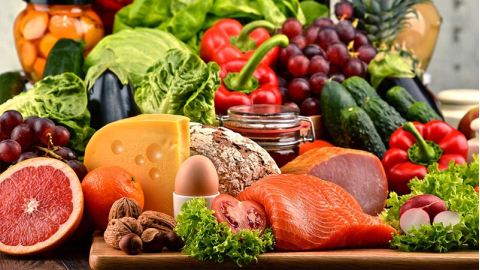
Have you ever wondered how to keep your food fresh and safe for longer? The secret lies in proper storage temperatures! Controlling the temperature correctly not only extends the shelf life of your food but also prevents the growth of harmful bacteria, safeguarding your family's health. This article will provide you with detailed information on the ideal temperatures for various food types and offer helpful tips for effective preservation.
Why Is Temperature Crucial in Food Preservation?
Temperature plays a pivotal role in controlling the rate of food spoilage. Most bacteria that cause food spoilage and foodborne illnesses thrive in the "danger zone," which ranges from 5∘C to 60∘C (41∘F to 140∘F). Keeping food below or above this range significantly slows down or completely stops their growth, helping food retain its flavor, quality, and safety. Improper temperature control is one of the leading causes of foodborne illnesses, making it a critical aspect of home food safety.
When food is left in the danger zone for too long, bacteria can multiply to dangerous levels, even if the food looks and smells fine. This is why understanding and maintaining the correct temperatures is not just about keeping food fresh, but about preventing serious health risks.
Ideal Storage Temperatures for Various Food Types
To optimize your food preservation efforts, let's delve into the ideal temperatures for common food groups:
1.Fresh Meats, Poultry, and Seafood
Refrigerator: The ideal temperature is below 5∘C (41∘F), preferably between 0∘C and 4∘C (32∘F and 39∘F). This range is safe for slowing bacterial growth. Always wrap fresh meats, poultry, and seafood tightly and place them on the lowest shelf of your refrigerator to prevent any drips from contaminating other foods. Use separate cutting boards and utensils for raw meats to avoid cross-contamination.
Freezer: For long-term preservation, your freezer temperature should be maintained at −18∘C (0∘F) or lower. At this temperature, bacterial activity is virtually halted, allowing frozen foods to remain safe for many months, sometimes even longer, depending on the item. Ensure food is properly sealed to prevent freezer burn, which, while not a safety issue, can affect texture and flavors.
2.Fruits and Vegetables
Refrigerator: Most fruits and vegetables benefit from refrigeration, typically at temperatures ranging from 0∘C to 10∘C (32∘F to 50∘F), depending on the specific type.
o Leafy Greens, Carrots, Broccoli: These are best stored at around 0∘C to 4∘C (32∘F to 39∘F). Store them in your refrigerator's crisper drawer, which is designed to maintain optimal humidity levels.
o Potatoes, Onions, Garlic: These should be stored in a cool, dark, and dry place, away from direct sunlight, at temperatures around 7∘C to 10∘C (45∘F to 50∘F). Avoid refrigerating them, as low temperatures can alter their texture and flavor, converting starches to sugars in potatoes, for instance.
o Bananas, Tomatoes, Avocados (unripe): These are best ripened at room temperature. Once ripe, some, like tomatoes and avocados, can be refrigerated to extend their shelf life, though some, like tomatoes, may experience a slight loss of flavor or texture.
3.Dairy Product
Refrigerator: Milk, yogurt, cheese, and other dairy products must be kept at temperatures below 5∘C (41∘F), ideally between 2∘C and 4∘C (36∘F and 39∘F). Always keep them tightly sealed and store them in the coldest part of your refrigerator, typically the back of the top or middle shelf, rather than the door, which experiences more temperature fluctuations.
4.Cooked Foods and Leftovers
Refrigerator: Cooked foods and leftovers should be cooled rapidly (within two hours of cooking) and stored in the refrigerator at a temperature below 5∘C (41∘F). Divide large portions into smaller, shallower containers to speed up the cooling process.
Freezer: For longer preservation, cooked foods can be frozen at −18∘C (0∘F) or lower. Label and date all frozen items for easy tracking. When reheating, ensure food reaches an internal temperature of 74∘C (165∘F) to kill any potential bacteria.
5.Eggs
Refrigerator: Eggs should be stored in the refrigerator at temperatures below 5∘C (41∘F). While some countries store eggs at room temperature, in many regions, especially North America, eggs are washed and therefore require refrigeration to prevent bacterial growth. Keep them in their original carton to protect them from absorbing odors from other foods and to prevent moisture loss.
Essential Tips for Effective Food Preservation
Beyond knowing the ideal temperatures, several practices can significantly enhance your food preservation efforts:
Invest in a Refrigerator/Freezer Thermometer: This is a simple yet crucial tool to ensure your appliances are consistently maintaining the correct temperatures. Don't rely solely on your appliance's dial settings; an independent thermometer provides accurate readings.
Don't Overload Your Refrigerator: A packed refrigerator can restrict airflow, leading to uneven cooling and warmer spots. Allow adequate space for air to circulate around food items.
Minimize Door Opening: Every time you open the refrigerator door, warm air enters, increasing the internal temperature. Try to be quick and organized when getting items out.
Use Airtight Containers: Airtight containers prevent spoilage, keep food fresh longer, and prevent odors from spreading. They also protect food from absorbing flavors from other items in the fridge.
Practice First-In, First-Out (FIFO): Use older items before newer ones to reduce waste. Regularly check expiration and "best by" dates.
Thaw Food Safely: Never thaw frozen food at room temperature. The safest methods are in the refrigerator, in the microwave (if cooking immediately), or under cold running water. Thawing in the refrigerator can take longer but is the safest method as it keeps the food out of the danger zone.
Clean Your Appliances Regularly: Spills and crumbs can harbor bacteria. A clean refrigerator and freezer are essential for effective food storage.
Label and Date Everything: This seems obvious, but it's often overlooked. Clearly labeling food with its contents and date of storage helps you keep track of shelf life and prevents unnecessary waste.
Mastering the knowledge of food storage temperatures is an essential skill for ensuring food safety and reducing waste. By adhering to ideal temperature guidelines and implementing these helpful tips, you'll consistently provide safe, delicious, and nutritious meals for your family. Start practicing these habits today to become a home food preservation expert!
Ready to explore reliable freezing solutions? Visit https://sanaky.com.vn/ to find the perfect chest freezer for your needs !
--------------------------------------------------------------------------------------------------------------
SANAKY VIETNAM., CO LTD - Manufacturer of Chest Freezer - Upright Cooler, Transformer, RO Water Purifier...
 Vietnamese
Vietnamese  English
English  Chinese
Chinese  French
French  Spanish
Spanish  Russian
Russian  Arabic
Arabic  Portuguese
Portuguese